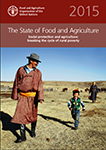Social protection schemes, such as cash transfers, public works and school feeding, are a critical component in eradicating hunger and poverty and improving education, health and life chances, according to the Food and Agriculture Organization of the UN (FAO).
The 2015 issue of the 'State of Food and Agriculture' recommends expanding social protection programs in rural areas and linking them with inclusive agriculture growth policies, to help poor and vulnerable people “break out of the poverty trap.”
 13 October 2015: Social protection schemes, such as cash transfers, public works and school feeding, are a critical component in eradicating hunger and poverty and improving education, health and life chances, according to the Food and Agriculture Organization of the UN (FAO). The 2015 issue of the ‘State of Food and Agriculture’ recommends expanding social protection programs in rural areas and linking them with inclusive agriculture growth policies, to help poor and vulnerable people “break out of the poverty trap.”
13 October 2015: Social protection schemes, such as cash transfers, public works and school feeding, are a critical component in eradicating hunger and poverty and improving education, health and life chances, according to the Food and Agriculture Organization of the UN (FAO). The 2015 issue of the ‘State of Food and Agriculture’ recommends expanding social protection programs in rural areas and linking them with inclusive agriculture growth policies, to help poor and vulnerable people “break out of the poverty trap.”
SOFA 2015 reports that some form of social protection is currently provided in at least 145 countries, benefiting 2.1 billion people in developing countries and keeping 150 million people out of extreme poverty. Still, the number of poor people covered by social protection is only one-third of the world’s poorest people. The lowest coverage rates are in South Asia and sub-Saharan Africa, which also have the highest incidence of extreme poverty.
FAO Director-General José Graziano da Silva called for urgent action to support the most vulnerable from hunger. He explained, “Social protection programs allow households to access more food – often by increasing what they grow themselves – and also make their diets more diverse and healthier. These programs can have positive impacts on infant and maternal nutrition, reduce child labor and raise school attendance, all of which increase productivity.”
According to the report, eradicating hunger by 2030 is possible with an investment of US$67 billion annually in income supplements through social protection programs, in combination with pro-poor investments in agriculture and rural development. This figure is less than 0.1% of world gross domestic product (GDP), according to FAO.
The report also states that the perception that social protection reduces people’s work effort is a myth, explaining that recipients often use the support to improve children’s education and nutrition, and arguing that it strengthens livelihoods rather than fostering dependency. SOFA 2015 showcases positive examples from Bangladesh, Brazil, Ethiopia, Ghana, Lesotho and Zambia.
FAO released the report in advance of World Food Day, which takes place on 16 October. This year the Day will focus on the role of social protection in breaking the cycle of rural poverty.
The 42nd Session of the Committee on World Food Security (CFS 42), taking place at FAO headquarters in Rome, Italy, from 12-15 October 2015, is also addressing issues related to food security, nutrition and hunger. [UN Press Release] [FAO Press Release] [Publication: State of Food and Agriculture 2015: Social protection and agriculture: breaking the cycle of rural poverty] [IISD RS Coverage of CFS 42]